On the Question of Tattoo by Ancestral Chamorus
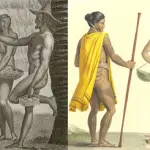
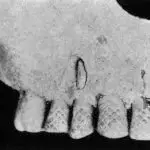
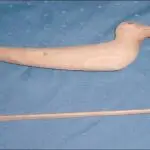
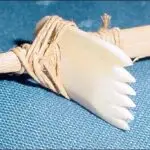
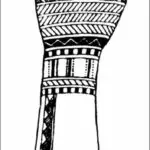
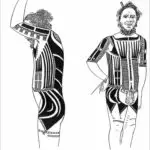
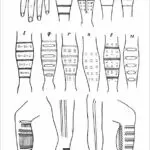
Table of Contents
Share This
Interpretive essay: No evidence of CHamoru tattoo from ancient times
Tattoo is often thought to have been a universal cultural practice in the Pacific Islands. However, that probably isn’t true. Archaeologists have found no evidence that the CHamoru/Chamorro people of the Mariana Islands used tattoo.
Many Pacific islanders practiced tattooing, as documented by European explorers and adventurers such as Captain James Cook in the late 18th century. Published accounts of these exploratory voyages include drawings of elaborately tattooed adults, as well as the architecture, artifacts, and other aspects of aboriginal life in the tropical islands, albeit seen through European eyes.
Some of the most dramatic tattoo designs were recorded among the Marquesans of eastern Polynesia and the Maori (indigenous peoples) of Aotearoa (New Zealand).
Highly distinctive, if less well-known among scholars, and rarely publicized in popular media, are the tattoos of higher-ranking Caroline Islanders of Micronesia. Intricate tattoos were worn by residents of the coralline islands of the Marshalls and Kiribati (previously called the Gilberts) as well.
While tattooing was nearly universally practiced in the Pacific Islands, the culture of the indigenous residents of the Marianas, known as CHamorus, appears exceptional in this regard. While tattooing may have existed among the ancestral CHamorus, there are no records of this in early travelers’ accounts, nor has evidence for tattooing been recognized in the archaeological record. In order to explore this issue further, it is important to consider the potential sources of information on the subject of body modification practices in the Marianas, including tattooing.
There are three relatively direct sources of information about ancestral CHamoru body modification: linguistics, archaeological findings, and early historic period accounts written by foreigners who visited the Mariana Islands and took the trouble to make observations on the local culture (not all visitors did).
Each of these information sources have their strengths and weaknesses. For example, linguistic studies can determine whether a language contains terms referring to a specific cultural practice such as tattooing. If the CHamoru language once had but has lost all the words referring to tattooing because the custom ceased during the early European contact period, then the vocabulary recorded after it had ceased would not reveal the past existence of tattooing.
An absence of words that refer to tattooing does not prove that such words did not once exist in the CHamoru language, but the likelihood that the custom once existed but ceased (along with the terms associated with it) during the early European contact period needs to be considered in light of other lines of evidence, such as late prehistoric archaeology and written accounts from the early European contact period.
The archaeological record, composed of physical remains, can be trusted implicitly because it has no deliberate or unintended bias. It doesn’t lie, misconstrue, purposely omit, or embroider the truth; it has no agenda. Archaeological remains objectively represent many past events and processes, yet they are subject to deterioration in the ground and are often fragmentary. The meaning of archaeological materials as we find them today is not obvious; these ancient records of an ancient culture are difficult to “decode” or interpret.
As anthropologists of the past, archaeologists try to make sense of the fragments of pottery, stone, and bone that they find through excavations. To do this, they imagine how those items once participated in human activities, and how they finally came to rest in the ground. In addition to understanding the cultural and natural processes of loss, burial, and deterioration that form the archaeological record, archaeologists need theories about how human activities and their associated physical remains likely were organized within the cultural system that produced those remains. In the young science of archaeology, reliable theories about these matters are scarce, and there is much yet to be learned.
Ethnographic descriptions can be useful in archaeological interpretation, especially if they pertain to the time period and location under study. However, no ethnographer visited the Marianas until the 20th century, long after ancestral CHamoru culture had evolved far from its 16th and 17th century organization and content. In addition, what an ethnographer decides to record does not always help answer archaeological questions. That is why some archaeologists these days do their own “ethnography” in the locations where they work, when it is clear that there is much continuity between the prehistoric past and the present.
Historic accounts, on the other hand, may be biased and inaccurate, as well as incomplete, regarding subjects of interest to us now. Some accounts contain eyewitness information of relevance, but care must be taken in evaluating the suitability of such information for our present inquiries. This is an acknowledged problem faced by historians and other scholars. One of the ways to establish the reliability of older texts is to compare each with the others, for consistency in what they describe. The more consistent the information on a given subject, the more likely the accounts reflect a past reality. If linguistic, archaeological, and written sources agree, we can be more confident in our inferences about the past.
Linguistic study on tattoo
The word tattoo as used in English nowadays appears to derive from languages spoken in Polynesia, such as Tahitian and Samoan. First written in 1769 as tattow in the diary of the English sea captain James Cook, while he was in Tahiti, tattooing there was defined by Cook as, “inlaying the Colour of Black under their skins, in such a manner as to be indelible.”
Were there terms for tattoo in the ancestral CHamoru language? Written accounts of CHamoru began nearly 150 years after Magellan had reached the Marianas, with the work of Jesuit missionary Luis Diego de San Vitores. According to linguist Donald M. Topping, San Vitores’ records, “are too sketchy to give a very clear picture of what the language was like in his day,” which was c. 1668. The priest was concerned mainly with communicating religious ideas with the CHamorus, not in recording ethnographic information about them.
Some two hundred years later, a Spanish grammar of CHamoru, Grammatica Chamorro by Luis de Mata y Araujo was published in Manila by Giraudier in 1865. This work also lacked a comprehensive CHamoru vocabulary, being focused upon the structure of the language. It was too late as a document of ancestral CHamoru cultural practices because by the mid-19th century, the CHamoru language included many borrowed terms from Spanish and from the languages of immigrants who had come with the Spanish, mainly from the Philippines but also other countries such as Mexico.
Half a century after the Spanish grammar of de Mata y Araujo came William E. Safford’s The Chamorro Language of Guam, published in 1909. This work focused upon CHamoru language structure and gave example sentences using common vocabulary words. Terms related to tattooing are absent from Safford’s study.
Nearly a century passed before CHamoru vocabulary was systematically codified in Chamorro-English Dictionary by Donald M. Topping, Pedro M. Ogo, and Bernadita C. Dungca, published in 1975. This work lists tatu as the CHamoru word for tattoo and tahu meaning cut, cutting, slice, incision. In the Philippine language, Tagalog, the verb to tattoo (“to mark the skin in patterns by pricking it and putting in colors”) is given as magtatú, tatuhán, or itatú (from Eng.)” in the English-Tagalog Dictionary by Leo James English, published in 1977 by Congregation of the Most Holy Redeemer, in Makati, Manila. According to this dictionary entry, Tagalog terms for tattooing came into the language from English.
As can be seen from the available sources, written records of CHamoru vocabulary were sparse and unsystematic until several centuries after Spanish colonization and since many cultural changes, including the absorption of several words from Spanish and other languages, had occurred in the Marianas. It is not clear whether the similarities between Tagalog words for tattoo and the contemporary CHamoru term for tattoo indicate recent borrowing by CHamoru from English or Tagalog, or whether it is an ancient word that was present in the language prior to European contact times. More research into this topic is certainly warranted in the CHamoru case.
In the Caroline Islands, despite over a century of foreign rule, terms referring to tattooing are present in the languages whose speakers practiced tattooing until it was banned by colonial administrations in the 20th century. Not only are the terms for the action of tattooing still known, but also the terms for specific tattoo designs and knowledge of where they should be placed on the body (for example, see Woleaian-English Dictionary by Ho-min Sohn and Anthony F. Tawerilmang in 1976; Ponapean-English Dictionary by Kenneth L. Rehg and Damian G. Sohl in 1979; Yapese-English Dictionary by John T. Jensen, published in 1977). These terms do not resemble the Polynesian terms and appear to derive from a different source or sources.
Given the sparse documentation of early European contact period CHamoru language and especially its vocabulary, we can turn to another kind of information, foreigners’ eyewitness accounts of the physical appearance of the CHamorus during the time in history when the ancestral CHamoru cultural system was still intact.
Early written accounts of body modifications
Beginning in the 16th century, European explorers and their associates penned the first written descriptions of the CHamorus. These accounts were written nearly 200 years before the Spanish formally colonized the Marianas. Antonio Pigafetta, who was a passenger on the first trans-Pacific voyage to be undertaken by Europeans, under the leadership of the Portuguese navigator Ferdinand Magellan, produced the earliest document. Magellan’s three ships arrived in the Marianas in March 1521. The landing spot was likely either at Guam or Rota. The discussion by Robert Rogers and Dirk Ballendorf “Magellan’s landfall in the Marianas,” 1989 Journal of Pacific History, favors a landing in Guam’s west central coast.
The three-day encounter between Europeans and CHamorus began and ended badly. We know this because it was recorded by Pigafetta. Evidently no CHamoru oral histories of Magellan’s arrival in the Marianas have survived.
Although brief, Pigafetta’s account is detailed. It tells how hundreds of CHamorus surrounded the European ships in their canoes and were eager to obtain anything made of iron from the Europeans, and how the latter badly needed fresh water and produce. Both sides gained some of what they desired but the losses were very uneven: the Europeans lost a skiff (later retrieved) and suffered no casualties, while the CHamorus experienced painful death by cross bow and musket and the fiery destruction of several of their houses and sailing canoes. In between the violent interactions that occurred on land and sea, Pigafetta and others went ashore and observed some of the local customs. They could communicate only by gestures.
Pigafetta’s account of these brief visits to the villages mentions several types of body modification, but not tattoos.
Later reports and commentaries about the CHamoru people and their way of life were produced by European clerics and other foreigners prior to the turbulent decades preceding Spanish colonization in 1668 and conquest in 1700. These accounts contain obvious biases, usually promoting the Europeans’ goals and often denigrating and/or misunderstanding local customs. Some accounts contain information that can be evaluated for consistency in their descriptions of CHamoru body modification and related practices and beliefs. Of those accounts that are consistent in describing the types of modification of the body, as well as styles of dress, tattooing is not among them.
The earliest European visitors to the Marianas, those arriving between 1521 and 1700, were not trained anthropologists or journalists, and they rarely made drawings (of course they had no cameras or tape recorders). Most of these visitors were intent upon converting the CHamorus to the Catholic faith and had no respect for (and little understanding of) indigenous customs, regarding them as inferior to their own beliefs and traditions.
Some writers appear to have been less condemning, if not more objective, than most others. For example, the Catholic lay brother Juan Pobre de Zamora wrote a detailed and empathetic account of his nine-month stay with a chiefly family in Rota in 1602. This account remains one of the best sources of information about pre-colonial (though not pre-Manila galleon) CHamoru culture as practiced in this small island just north of Guam.
The process of Hispanization of the CHamoru culture was well under way by the late 18th and early 19th century, the time when European scientific expeditions began to visit the islands. For example, in 1819 the French expedition led by Louis de Freycinet arrived with illustrators and trained naturalists and stayed in the Marianas for three and a half months. Only “memory culture” of prehistoric times had been passed on through certain families, such as that of Luis de Torres, a high-ranking government officer. The cultural memories retained by the Torres family and imparted to Freycinet pertained to practices from well over a century earlier.
This kind of information is subject to many of the same problems as other secondary sources. While its accuracy in this case may be relied upon to a great extent, its comprehensiveness is lacking since only certain cultural practices were recalled and recorded. Nonetheless, Freycinet’s richly illustrated reports, especially the Atlas historique, are important contributions to the documentation of Marianas material culture and demographic status in the early 19th century. They reflect the incorporation of Spanish and Carolinian traditions into a CHamoru base that had begun a millennium or more earlier. It is perhaps not insignificant that tattooing was not mentioned by Freycinet’s CHamoru informants, nor were any CHamoru tattooing instruments collected or illustrated.
Descriptions of ancestral CHamoru body modifications
According to several 16th and 17th century sources, compiled and quoted from Lévesque’s translations by archaeologist Robert York, the CHamorus of that time modified their bodies in a variety of ways. Among the adult men, these modifications included blackening of the teeth; sharpening of the teeth; anointing the body and hair (always described as black) with coconut oil; wearing long beards; having very long hair (down to the waist-line) worn loose or tied with one loop at the back or with a knot at the crown, some with two knots; having mustaches but all other facial hair removed; shaving the head entirely except for a small tuft at the top; and scarring of the skin caused by love bites. Men wore garlands and headbands of very fine tree bark and various kinds of necklaces, some of red shells, in a style worn over the back rather than over the chest. Hats and sandals were also worn.
Adults of both sexes carried a small, finely woven basket that contained betel nuts, pepper leaves, and lime. A consequence of habitual betel nut chewing was a reddish-brown stain on the teeth, differentiated in these accounts from deliberate blackening produced by the use of dark soil and other ingredients.
Women are described as wearing their hair very long and loose, sometimes reaching the ground, or tied and braided; bleaching the otherwise black hair blond to white, either entirely or in streaks or at the tips; coloring the hair with yellow streaks (possibly with turmeric?); blackening the teeth; scarring of the skin caused by love bites; beating the outside of the lower legs to raise a desired pattern of welts; and tracing images on the face and upon various parts of the body (no indication of how these images were made but they were not called tattoos in these accounts). Dress was more elaborate among women than men; the pubes were covered with tree leaves, mats, or narrow strips made from the inner bark of the palm tree, turtle shells, or other “plate-like” objects; and young women wore a red string around the waist. Like the men, women wore hats and sandals; for special occasions various skirts or mats were worn along with jewelry and flower wreaths and garlands.
One observer, Fr. Martin Ignacio de Loyola, in 1581, stated that the CHamorus were, “well proportioned, without any tattoos nor other ugliness, but just as God made them.” This is the only known direct statement averring the absence of tattooing among the CHamorus. By stating what was not observed, it shows an awareness of (and a negative attitude toward) the practice of tattooing among other people known to the writer at that time.
It is possible that tattooing existed in the Marianas during early European contact times but was a custom restricted to a few individuals who happened not to have been observed by any of the foreign visitors. However, some of these foreigners stayed for several weeks and interacted frequently with the CHamorus. If the visitors were able to describe other types of body modification during their stays, it seems likely that they would have noted any tattoos had they been present.
Another possibility is that CHamoru tattoos were very small and/or placed on the body where they were not easily seen. Hidden tattoos seem unlikely since all who wrote descriptions of the islanders at this time mentioned the consistent absence of clothing and noted several other types of body modification. If CHamoru tattoos were small and deliberately concealed, this would contrast with the general pattern among Pacific Islanders who are known to have practiced tattooing. Their tattoos were relatively large and were placed on the body so they could be displayed to others. Among these groups, the two main “reasons” for receiving tattoos were to mark an individual’s inherited social rank or achieved status (for example, as a warrior or a navigator) and to prove ethnic affiliation, as among the I Kiribati (Gilbertese).
Tattooing was actively discouraged and eventually outlawed by colonial administrations in Micronesia. Perhaps as a result of this, there was a trend toward the use of smaller and more sparsely distributed tattoos on the body, particularly during the 20th century. In the island cultures where tattooing was traditional but had been banned for many years, a few individuals continued to obtain tattoos, and these tended to be placed in small groups on the arms and legs. Coverage of the face, torso, and back declined or ceased entirely.
As with many customs involving social information, aesthetics played an important role in Pacific Island tattoo designs, which often reflected naturalistic elements such as birds and fish. These permanent markings on the skin evoked admiration for their beauty and symmetry as well as for the courage and stamina of the bearers for undergoing the painful experience of receiving the tattoos. The tattoo artists were compensated for their work, a sign of its importance to the community, and its high value to the individuals who acquired these skin markings at great personal cost.
In the Marianas by the early 19th century, CHamorus had adopted many European practices and had rejected several indigenous ones, such as deliberate tooth blackening and the distinctive hairstyles described in early accounts. Concepts of individual attractiveness were changing. Tattooing indeed occurred in the Marianas, as recorded by the Freycinet expedition, but seemingly only among the pagan Carolinian people who, by this time, occupied small settlements in Guam and Saipan with permission of the Spanish governor. CHamoru notions of modesty were derived from Catholic teachings, and simple Spanish-style clothing, similar to that also worn in the Philippines then, was favored, along with European-style ornaments such as crosses and rosary beads.
Archaeological findings
Archaeology rarely provides direct information about past cultural practices, but ancient artifacts can reflect certain activities associated with those practices. For example, if the instruments used to apply tattoos were found at an archaeological site, it could indicate that this activity had taken place in the past.
Information about what tattooing equipment may have looked like is absent in written accounts of the ancestral CHamorus, but information is available for neighboring islands such as Yap and Palau since descriptions of tattooing equipment and how it was used have been recorded and examples exist. Where tattooing has continued as part of the indigenous culture, such as among the Maori, study of the methods and equipment used can help archaeologists in their search for evidence among ancient remains.
According to other Micronesian and Polynesian tattooing customs, tattooing instruments in the Pacific were and are made of organic materials. They consist of two main parts, a lightweight hammer and a puncturing device attached to a lightweight handle. The hammer is usually a narrow length of wood, heavier at the hammer end. The puncturing device consists of a short row of tiny barbs forming a rake, attached to the end of a slim wood or bamboo handle. The puncturing device is attached to its handle by delicate fiber lashing through one or more small holes. The barbs are created by filing a short row of sharp points along the edge of a small, flat piece of bone or marine shell.
Other materials said to be used to make barbs include citrus thorns, sea bird bones, and shark teeth. Only the more durable of the organic materials used to make tattooing instruments, such as marine shell, bone, and teeth, could survive for centuries buried in the ground where artifacts are subject to periodic wetting, and then only if the soil is not very acidic. Acidic soil can destroy even these hard materials, as well as wood, which can rot quickly from exposure to heat and moisture. So far, no tattooing instruments or parts of them have been recognized at archaeological sites dating to late prehistoric times in the Marianas, called the Latte Period by archaeologists.
The Latte Period refers to the time in the prehistoric past when stone pillars, each topped by a hemispherical capstone, both called latte, were used to support dwellings and canoe houses. Tattooing instruments may have existed during the Latte Period, but have not survived due to adverse preservation conditions. Soil acidity in the Marianas is not always high, especially at coralline beach locations, yet no tattooing instruments have been recognized in those or any other cultural deposits.
Two types of body modification are directly indicated in the late prehistoric Marianas archaeological record: marking of the adult front teeth with incised designs and tooth staining. Incised designs on front teeth were not described by any of the European observers, but several accounts mention the practice of tooth staining and some give details on the methods used. Dark brown staining is often observed on the teeth of Latte Period adult burials, both men and women (but not children). Staining of the teeth appears to have resulted from years of betel nut chewing; another cause could be deliberately applied black soil or other coloring agents as described in early historic accounts.
Relatively few adult burials dating to the Latte Period have been observed with tooth incising. This kind of body modification consists of geometric designs and short lines on the outer surface of the front teeth. The designs were fashioned by cutting straight lines onto the tooth surface that was previously stained. The shallow incisions did not actually penetrate the tooth enamel, they just removed a small amount of the staining. This delicate technique caused the whiteness of the tooth beneath the staining to make a patterned contrast. Such tooth marking may have had to be repeated periodically in order to stay effective, if the person continued to chew betel nuts.
A puzzle
The evident lack of historic documentation of tattooing among the ancestral CHamorus presents a puzzle. If tattooing was practiced, why didn’t observers who noted and wrote about other kinds of body modification among the CHamorus of the 16th and 17th centuries make mention of it? Why is there no linguistic or archaeological evidence for tattooing in the Marianas?
If tattooing was truly absent, what might be the reasons for such a difference between the ancestral CHamoru and other Pacific Island cultures, many of whom practiced tattooing? To answer this question anthropologically requires a different approach than one taken by those searching only for cultural similarities while ignoring cultural differences.
Scientifically minded anthropologists try to explain cultural similarities and cultural differences, and in Micronesia there are both. According to early European contact period accounts and the findings of linguistic and archaeological studies, ancestral CHamorus shared several practices with their neighbors in the Carolines, including growing many of the same tropical food plants (for example, taro, bananas, breadfruit, coconuts), holding regional festivals, and exchanging raw and prepared foods as well as shell bead and turtle shell valuables. According to linguistic research, all Pacific Islanders speak languages that have been classified as belonging to the same family, Austronesian (formerly called Malayo-Polynesian).
Linguists propose that these languages derive from a common ancestor far into the past. Some researchers have supposed that a common origin also accounts for similarities in many other aspects of Pacific Island cultures, but common ancestry does not explain the long persistence of these similarities over many centuries of life in the islands, as the archaeological record shows. A more likely cause is that common cultural elements (for example, similarities in plants cultivated and fishing equipment) have been retained over time because they proved successful under similar environmental circumstances (for example, tropical climate, pan-Pacific flora and fauna, small land masses, volcanic or coralline geology, etc.).
Anthropologically intriguing are the cultural differences among Pacific Island groups. Their study can lead to new insights regarding the causes of cultural variations, a major scientific goal in this field. Anthropologists have found that while speaking related but separate languages, Micronesians differ in their architecture, settlement pattern, and social organization. These differences exist despite longstanding interactions among these island cultures. It is apparent that the Pacific Ocean and its winds have not been so much a barrier to communication as a means of movement and exchange among seafaring peoples and their islands. With people move ideas, but not all ideas are adopted and differences are retained.
Differences reflect choices made by people, given their own particular circumstances, both environmental and social. Since tattooing has been practiced by many Pacific Island groups, including the Caroline Islanders from Palau to Kosrae, it is reasonable to ask what were the particular circumstances that gave rise to and sustained this practice in those islands, and conversely, it is reasonable to ask, did these circumstances also apply to the ancestral CHamorus?
Comparing local circumstances
In prehistoric Micronesia, very high human densities were achieved by the tropical farmers/fishers of the Carolines, probably because their islands were positioned within a zone of high annual rainfall and were relatively free from the frequent droughts and typhoons that trouble the Marianas. With reliable harvests and dense populations came competition for the limited arable land in these small islands.
Complex political systems of ranked lineages and clans arose to socially regulate this competition.
Hierarchical social systems distinguish between the privileged, who have access to desirable croplands and rarely suffer deprivation, from the less privileged, whose lands are sometimes inadequate, depending upon mismatches between local supply and demand. Rank is generally inherited, but in some cases can be altered through political negotiations. While Pacific Island cultures all have a sharing ethos, in hierarchical social systems, obligations to help others are more narrowly channeled along pre-determined lines, and, in times of shortage or imbalance between resources and people, lower ranked groups receive less and suffer more. Typically, higher-ranking families tend to marry and adopt only those of equivalent or higher rank, and other measures are taken to lessen any ambiguity regarding who are the members of the privileged ranks, and who are not. Tattooing identifies these individuals directly. In addition to making the body beautiful in the eyes of others, culturally prescribed tattoos convey important social information about the wearer.
In strongly hierarchical societies, this kind of information is critical to the maintenance of the status quo; it reflects stability and predictability in social relations, at least in the upper ranks.
In some Pacific Island cultures, sub-population membership that was conveyed by tattoos. For example, among the I Kiribati and Marshallese, everybody, even children, was required to be tattooed. In these tiny islands, productive land was at a premium, and the designs indicated where an individual came from and with whom he or she was socially affiliated. Pressure to acquire tattoos can be very strong because a person lacking them could not fully participate in society. In times of intense competition, which can arise from time to time, such identifiers are critical to survival of the individual and his or her social group.
From this brief overview, we can see that the particular circumstances in which tattooing has been practiced in Micronesia include dense human populations, whether due to highly productive agricultural systems that could support large numbers of people, or to chronic land shortage on very small islands where nearly every inch of ground was some sort of garden and population quickly reached natural limits. Competition was endemic in these societies, flaring up occasionally, and customary means were invented to prevent or at least minimize violent and destructive conflict; this included hierarchical social organization and group identifiers. In hierarchical social organizations, it is important to those with the most to lose, namely, the highest-ranking groups, to maintain the status quo.
Among the several ways this was done was to assert existing social ranking by tattooing members of the elite ranks, as in the Carolines.
In less hierarchical societies, such as the Kiribati (formerly Gilbertese) and Marshallese tattooing developed as a means to identify the members of a local population with claims to contested lands, such as an entire island. In all these societies, moving from one island group to another to relieve crowding was not an option for most since regional population densities were high.
Were the environmental and social circumstances in the Marianas the same as in the Carolines, Marshalls, or Kiribati? The answer is no, they were not. First, the geographic setting of the Mariana archipelago guarantees that droughts and typhoons occur frequently. This causes great year-to-year fluctuations in agricultural production, and overall population densities were low. The ancestral CHamoru farming system probably included techniques that minimized the effects of these environmental factors. Examples are planting several kinds of gardens in different locales and during productive years storing part of the harvest against future crop losses.
Latte Period archaeology reflects such a subsistence system. For example, in Guam, latte-supported dwellings housing one or two families were dispersed throughout the interior while coastal settlements were generally larger. It is not known how long people lived at each site but the lack of deep midden suggests short stays. Large pottery jar fragments at many of these sites, as well as at coastal locations, suggest food storage was practiced. That coastal and inland dwellers were socially connected is indicated in Juan Pobre’s account; he observed that those living at the coast were considered of higher status, and the latter regularly exchanged fish for plant foods provided by lower-status inland farmers. Evidently these exchanges were not entirely economically motivated, at least from the standpoint of coastal residents, since Pobre’s chiefly host maintained his own gardens.
A settlement system of dispersed inland dwellings occupied for short times near farm plots and larger coastal settlements where residents moved less often is an adaptation to uncertainties in harvests, with food exchanges helping to even-out shortages and to maintain positive social relations. The ancestral CHamoru social organization distinguished higher ranking families from middle and lower ranked ones, indicating social controls were in place to regulate competition, but it appears that this system was somewhat flexible and movement via sailing canoes between islands was swift and unrestricted.
This flexibility promotes wide kinship and friendship networks that increase the number of people from whom those temporarily in need may ask for help in times of food shortages, effectively spreading out the risk and the burden of social obligations. Choosing spouses and making good friends from locations widely separated in space helps to create these social networks, as does adoption of children across long distances, such as between islands. Frequent visits among friends and relatives and periodic regional festivals with many participants help to familiarize individuals with their distant neighbors and indicate the availability of spouses.
In this kind of social organization, personal generosity and willingness to share resources with friends and relatives are expected and admired, while behavior that excludes individuals, especially those related through kinship or friendship is, considered inappropriate. Conventions of personal attractiveness among adults, such as distinctive hairstyles and other decorative effects, as we have seen were part of ancestral CHamoru culture, are highly developed. An individual’s freedom to form social ties across a wide area translates into a kind of social security because when local conditions change for the worse, say, due to typhoon damage, those ties can be lifelines to safety, for an individual and his or her associates. It would make no sense to permanently align oneself only with one or two social groups. This is why it is unlikely that ancestral CHamorus practiced tattooing. Permanent markers of social affiliation, such as tattoos, would have been too restrictive.
Future research may reveal evidence that tattooing was indeed practiced in the Marianas, but there is another reason besides the lack of linguistic, historical and archaeological evidence to doubt that it was. The local environmental and social circumstances in this part of the Pacific made tattoo unnecessary. The ancestral CHamoru culture was similar in many ways to that of other Pacific Islanders, but it also provided unique and appropriate solutions to the challenges of life north of latitude 12 along the 145th meridian.
For further reading
Freycinet, Louis Claude Desaulses de. Uranie et Physicienne Voyage. Paris: Chez Pillet Aîné, 1825.
Omori, Emiko, dir. Skin Stories: The Art and Culture of Polynesian Tattoo. 2003, Honolulu: Pacific Islanders in Communications and PBS.
Spennemann, Dirk H.R., ed. “Tattooing in the Marshall Islands–Introduction.” Digital Micronesia–Marshall Islands–An Electronic Library and Archive, 1998.
Yatar, Maria Santos. With the First Canoe: Traditional Tatu of Micronesia. 1992.
